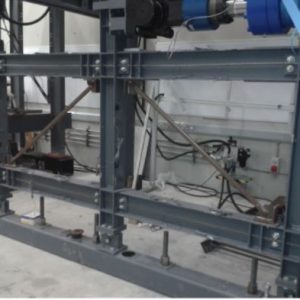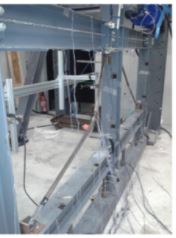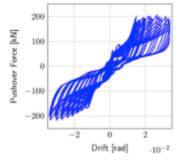
Braced Steel Frame

- Title
-
Development of a Novel Self-Centering Concentrically Braced Steel Frame System
- Project Partners
-
AECOM, TCD, NUI Galway
- Principal Investigator
-
Jamie Goggins, NUI Galway
- Research Area
-
Energy, Climate
Introduction
Resistance to seismic loading in steel structures is often provided by the use of concentrically braced frames (CBFs), which are designed to undergo numerous cycles of inelastic deformation through the tensile yielding and inelastic global buckling of its bracing members. This inelastic behaviour leads to the possibility that structures designed according to current codified approaches are likely to have residual deformations after a major seismic event, meaning the structure may have not collapsed, but large permanent deformations exist in the structure. These residual deformations represent a major problem as they can often render a structure unusable or cause significant delays such that the downtime associated with rectifying these residual deformations incur significant economic losses.
Aim
The aim of this project is to develop and test a novel CBF system in order to eliminate the occurrence of these residual deformations following major seismic events. This is done by combining the existing CBF system with a post-tensioning arrangement to give a self-centering CBF (SC-CBF). This post-tensioning arrangement consists of a series of strands running parallel to the beam members and between the beam flanges to be anchored at the exterior columns of the frame. This arrangement provides a re-centering system for the frame which ensures the self-centering behaviour of the novel system.
Work Packages
The mechanics of the SC-CBF are developed and the general behaviour is described. An experimental test setup is then designed to investigate a variety of SC-CBFs under quasi-static cyclic loading. This testing, conducted using the strong floor and reaction frame in the structures laboratory at the Engineering Building in NUI Galway, demonstrates both the self-centring nature of the SC-CBF, and also the added energy dissipation provided by the brace members. Using the results of the nine experimental tests carried out, a numerical model is developed and verified using OpenSees. The model is initially developed based on previous research in the modelling of CBFs and self-centring systems, and is then developed further for the specific arrangement of the SC-CBF. The model is validated using the results of the tests carried out, where both physical testing and numerical modelling are shown to be in good agreement. Finally, the development of the SC-CBF into a performance-based design (PBD) framework is presented briefly.
Deliverables
The outcome of this research is the proposal of a novel SC-CBF system to be used in seismically active regions. In light of this, a methodology is proposed which integrates the design of such a system into a PBD framework such that SC-CBF’s can be designed to incorporate different design goals corresponding to different seismic events of various return period.
Publications
Contact
Contact: Jamie Goggins, NUI Galway
Email: ei.yawlagiun@sniggog.eimaj
Photo Gallery






